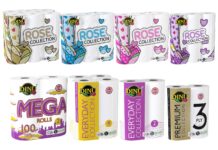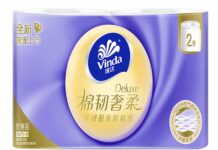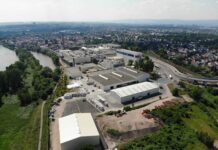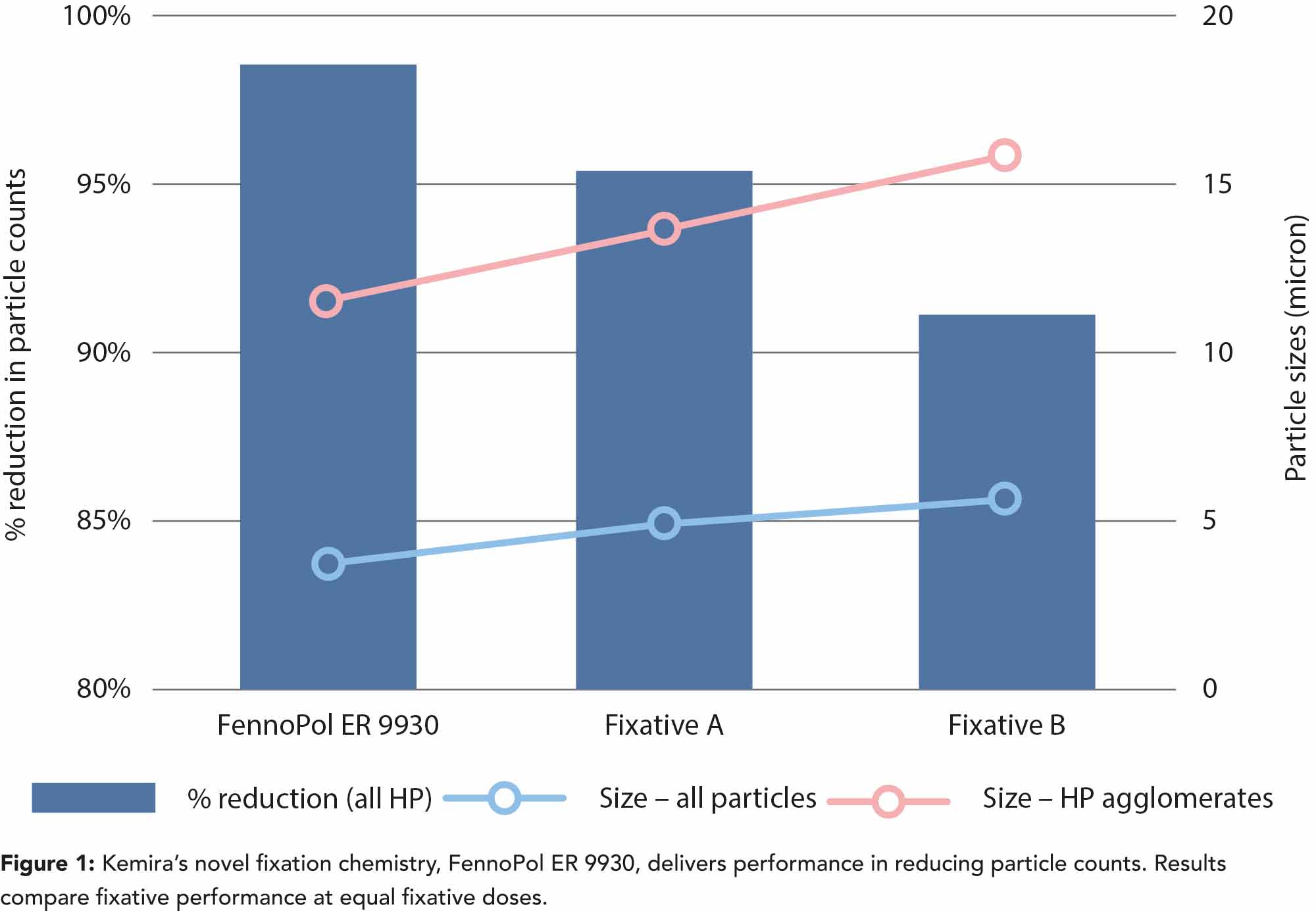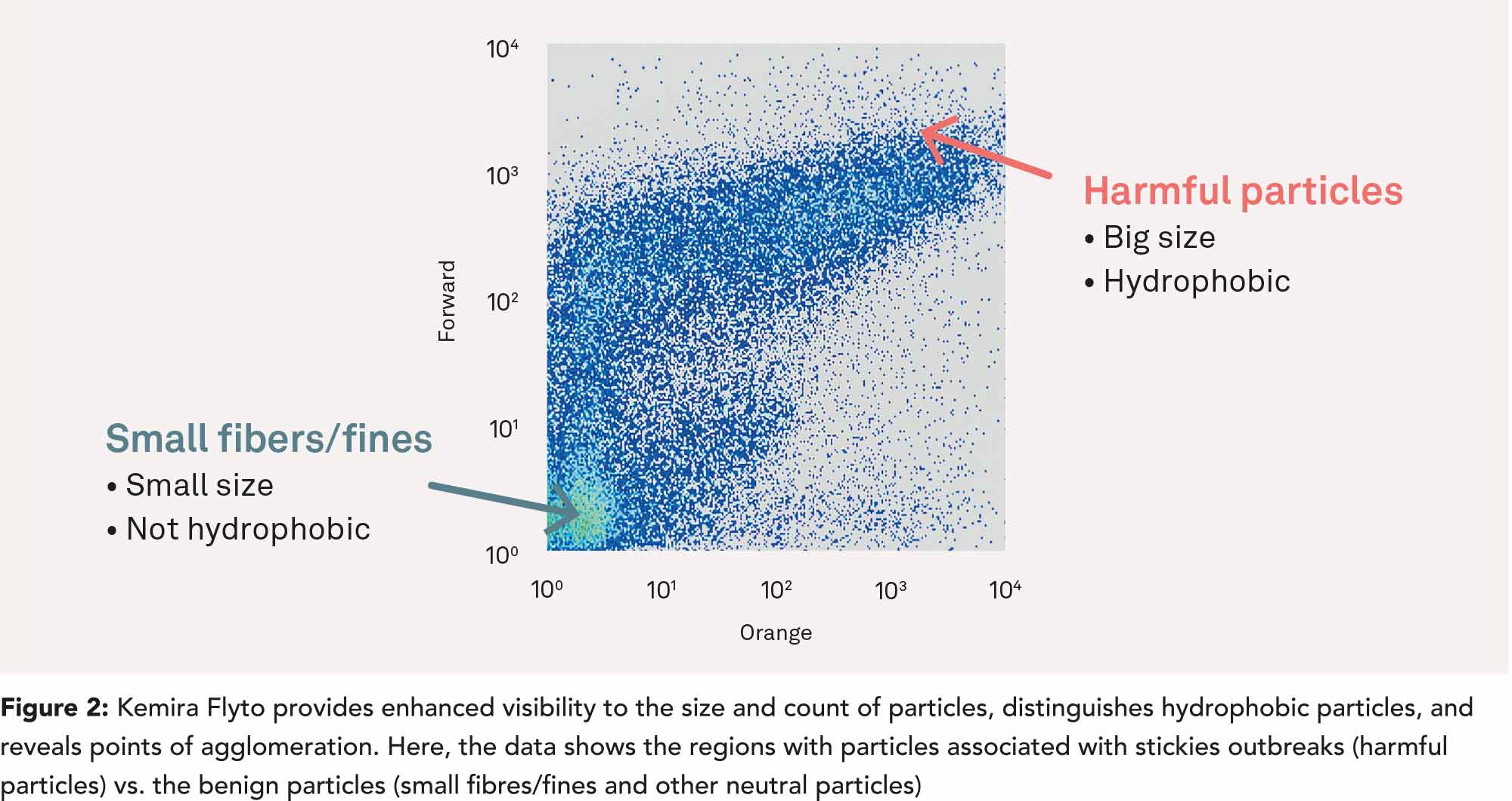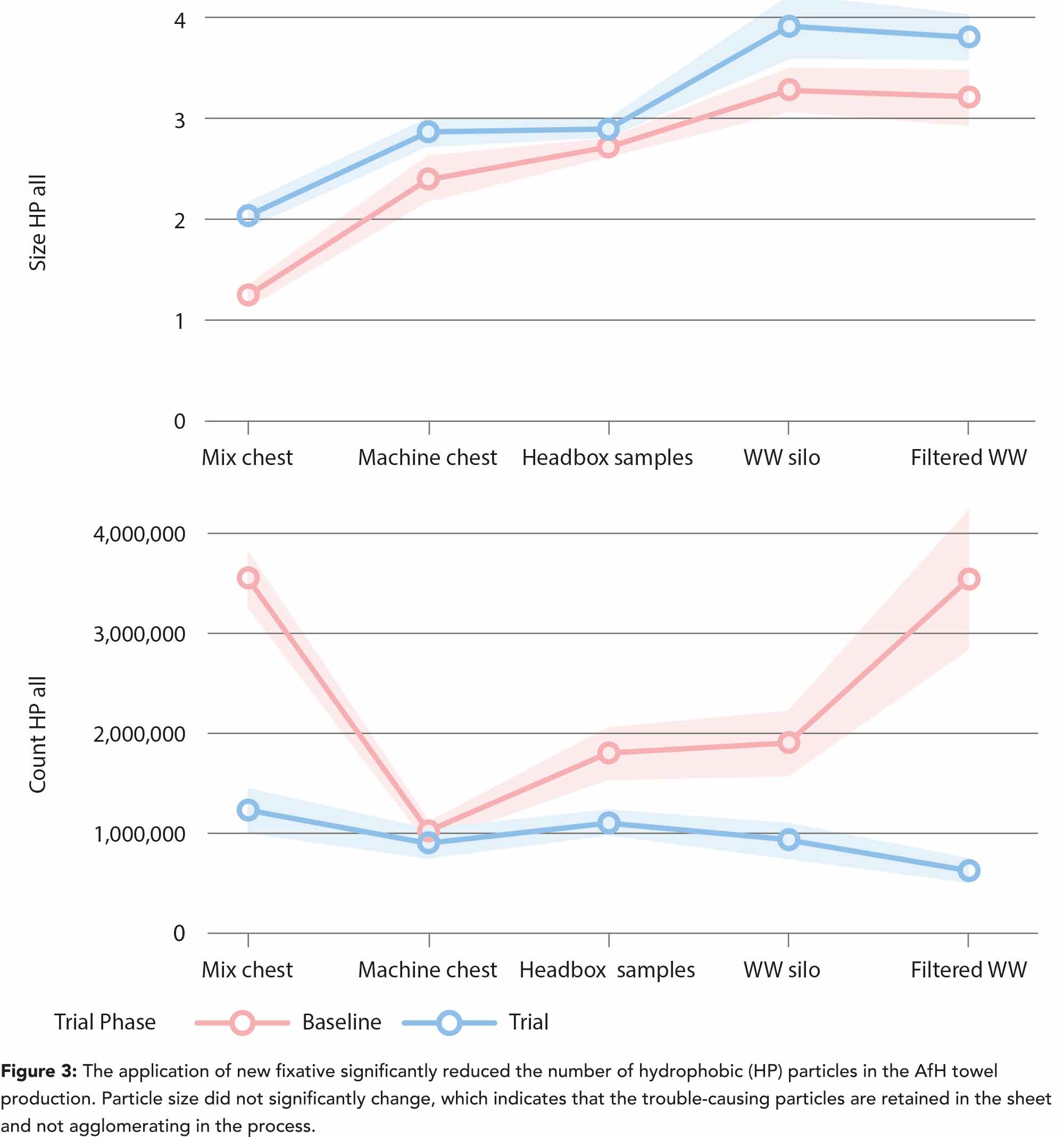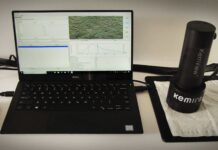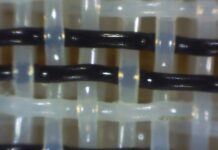A more refined solution to the increasing challenge is needed, says Albert Allen, Principal Specialist, Deposit Control, Pulp & Paper, Kemira. A TWM report.

The increase in recycled content and reduced water usage in tissue making has intensified operational issues and defects caused by stickies. Stickies are made up of agglomerations of hydrophobic particles (HP), for example adhesives, coatings, and inks in recycled materials, and are difficult to manage.
They are a significant challenge in the papermaking industry, particularly due to their tendency to adhere to machinery and finished products, causing operational issues and defects. These contaminants exhibit a range of melting points and degrees of tackiness, variously based on their chemical composition. This article presents a comprehensive and innovative solution to stickies control, combining a novel fixation chemistry and unique real-time monitoring technology, to enhance machine performance and product quality.
Several factors are leading to industry-wide increases in the occurrence of stickies-related issues. While many of these are beneficial for the environment, they lead to struggles in the papermaking process. The HP particles that make up the stickies often originate from various recycled sources that are used to displace virgin fibres in tissue grades.
As mills work to reduce the overall amount of water used to make paper, there is less dilution of contaminates and fewer ways to purge these unwanted materials from the process, leading to a higher level of HP contaminates and more potential for deposits and defects. Even weather extremes can impact this as higher temperatures can warm storage tanks and change the properties of the contaminants in the process, making them more tacky and likely to agglomerate.
Managing all this HP material is crucial for maintaining the quality and efficiency of tissue production. Traditional approaches to controlling stickies have been varied, focusing on individual stages of the production process, from pulping to effluent treatment. They have employed methods like detackifiers, enzymes, and dispersants.
However, these methods often lack a systematic approach, addressing only parts of the stickies problem. A more refined solution for stickies control is needed based on three key principles for managing HP particles:
- Keep HP particles small (microstickies) and stable
- Minimize the tackiness of the microstickies
- Fix these microstickies on the fibre
All recycled fibre and broke sources contain some HP contamination that will liberate as the paper is repulped. The first lines of defence are the physical removal processes, such as cleaning and filtration. Any material left over needs to be managed according to the strategy above.
These particles are hydrophobic and tend to agglomerate in water systems. Therefore, the first step to keep the particles dispersed is to maintain these microstickies rather than allow them to increase in size to the point where they become noticeable defects and deposits. Once the HP particles are stabilised as microstickies, the next step is to detackify or chemically passivate the particles. This will further prevent any tendency to move out of the water and stock mixture and deposit or form agglomerates on the fibres.
Finally, these pacified microstickies need to be thoroughly fixed to the fibres. Fixation will allow the contaminates to be retained in the sheet and removed from the system with the sellable paper. This is a primary route for removing the HP particles from the entire system and preventing the build-up of this material in the water loops, where they can agglomerate and lead to production upsets.
The final piece that is needed for effective control is monitoring. A method is needed to make meaningful measurements that can be related to process changes, thus enabling proactive chemistry adjustments to maintain programme performance.
This article presents a full-system approach to stickies control incorporating all three of these principles and sophisticated monitoring, which allows for chemistry adjustments to maximize program efficiency for improved machine performance. Two primary focus areas will be on a novel fixative, Kemira FennoPol ER 9930, designed for HP particle retention, and Kemira Flyto measurement technology.
Novel fixation chemistry
FennoPol ER 9930 represents a significant advancement in industrial fixatives, particularly in the paper production industry, where managing stickies is a critical aspect of the process. The innovative chemical structure of this cationic polyacrylamide emulsion, characterised by its high charge and low-to-medium molecular weight, is engineered to optimize the bonding process. Its mechanism of action is designed to target small stickies, effectively bonding them to fibres without the formation of larger, problematic agglomerates. This precise action helps maintain the integrity of the paper quality without disrupting the production process.
The application of FennoPol ER 9930 is streamlined for efficiency. It is a pump-and-go product that eliminates the need for a make-down unit, simplifying the integration into existing systems and reducing preparation time. This ease of use, combined with its superior performance in reducing particle counts and turbidity, positions FennoPol ER 9930 as a leading solution in the industry. The ability to maintain the smallest particle size is particularly noteworthy, as it directly correlates with the quality of the final paper product and the effectiveness of the stickies management process.
FennoPol ER 9930 has demonstrated the best performance, setting a new benchmark for others to follow, as shown in Figure 1. The reduction in particle size and counts not only enhances the quality of the paper but also contributes to the longevity and efficiency of the machinery used in the tissue-making process. By ensuring a more controlled and cleaner operational environment, FennoPol ER 9930 aids in reducing downtime and maintenance costs, which can lead to significant economic benefits for paper manufacturers. Moreover, the environmental impact of the paper production process is an ever-present concern, and the introduction of FennoPol ER 9930 offers potential ecological advantages. By improving the management of stickies, it may reduce the need for additional chemical treatments and the associated waste, thus contributing to a more sustainable manufacturing approach.
In summary, FennoPol ER 9930 is a testament to the ongoing innovation within the paper industry. It provides a solution that not only enhances the quality of the product but also streamlines the production process, reduces operational costs, and supports environmental sustainability. Its development reflects a deep understanding of the challenges faced in stickies management and showcases a commitment to advancing the industry through scientific and technological excellence.
Unique hydrophobic particle measurement
To achieve the next level performance and optimisation of fixation, enter Kemira Flyto measurement technology. Originally a well-known analytical method in medicine, flow cytometry, Flyto analyses particles in fluid suspension. It measures light scattering and fluorescence of each individual particle, as shown in Figure 2. Particle identification and classification are achieved by staining with selective fluorescent dyes. In the papermaking process, Flyto can count and characterise the particles in process water, filtrates, and pulp suspensions, providing crucial information for an efficient and optimized treatment process.
Flyto provides a breakdown of the size and count of the particles by categories, distinguishes hydrophobic particles, and highlights the points of agglomeration in the process. It enables a process survey to determine problem areas, pinpoint target treatment areas, and identify problem-causing raw materials. It also allows for observing the impact of dispersants and fixatives. For instance, it can show how a new fixative chemistry improves the retention of hydrophobic particles, leading to a significant reduction of particles in the headbox and water system.
Case study: holistic strategy in practice
An AfH towel machine had completed a project to close its water loop by reclaiming nearly all the white water, while also increasing the amount of recycled fibre and broke it was consuming. After completing these changes, it began seeing increased issues with stickies. This manifested as deposition on the fabrics, holes, and machine breaks.
To begin understanding the problem, Kemira Flyto was used to survey the HP particle content throughout the process. The broke was found to be the largest contributor of HP particles, with nearly two times the number of particles of the other fibre sources. The survey also showed a trend of increasing particle size following the addition of much of the papermaking chemistry. This information directed the structure of the stickies control programme. The primary dispersant dose was applied to the broke stream where most of the HP material was indicated, and the fixative was added prior to other machine chemistry to attach the microstickies to the fibres before they could agglomerate.
Upon implementation of the stickies control programme, further Flyto testing was conducted to monitor the impact of the chemistries on the makeup of the hydrophobic particles in the process. Changes were seen in the size of particles coming from the fibre sources, with the largest decreases occurring in the recycled fibre and broke. The application of the fixative resulted in a considerable reduction in the number of HP particles in the headbox and white water without a significant change in the particle size, as shown in Figure 3. This lack of particle size increase indicates that the reduction in particle count is due to them being retained in the sheet and not agglomeration. During this time, the machine experienced a 50% reduction in breaks, and little to no time lost due to removing deposits from the fabrics. In short, stickies were eliminated as a day-to-day issue on the machine.
Conclusions
Agglomerations of HP or stickies come from a variety of raw material sources widely used in the industry today. These containments can build up in the process to the point that they negatively affect production performance and final product quality. Kemira has developed and tested a whole system control strategy to reduce the concentration of HP particles and their agglomeration and to mitigate the resulting machine issues. When coupled with sophisticated real-time monitoring tools, tissue makers can achieve and maintain conditions that result in optimal performance through adjustments in the control programme.
This article was written for TWM by Albert Allen, Principal Specialist, Deposit Control, Pulp & Paper, Kemira.





